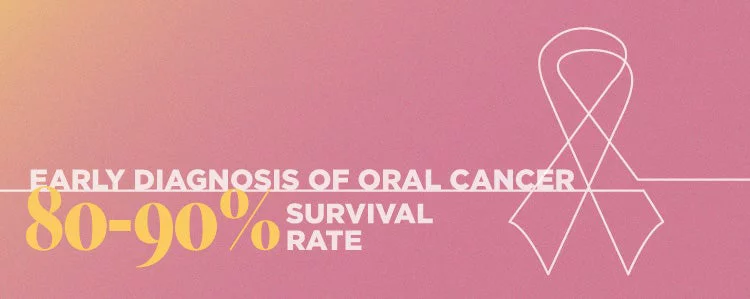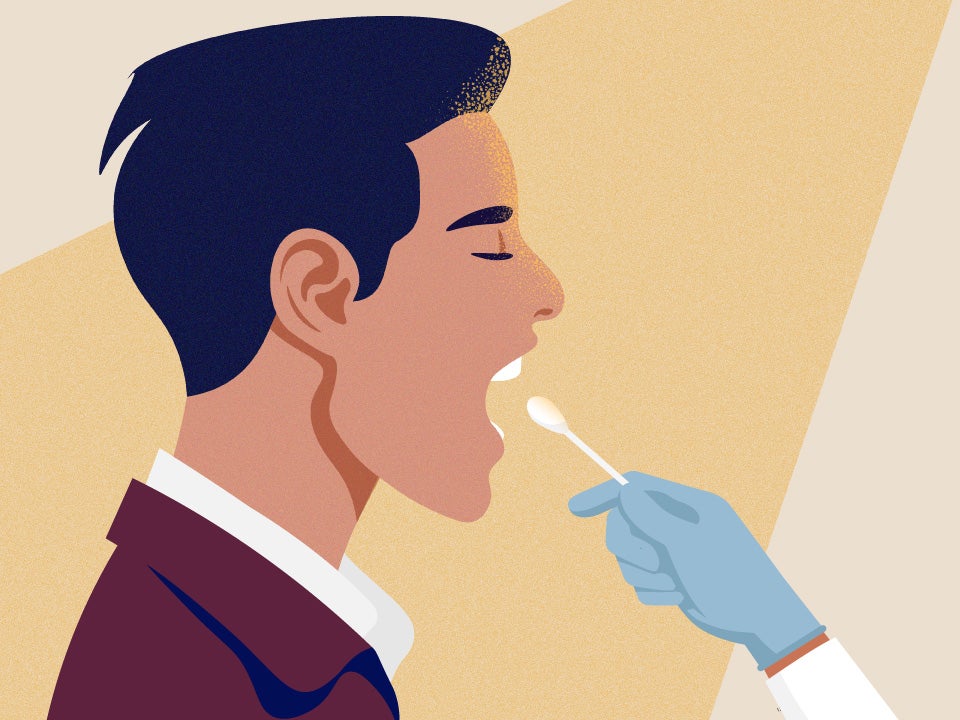Regular dental checkups are crucial for maintaining healthy teeth and gums. But routine dental appointments can also be a huge factor in your overall health, and may even save your life. Through oral cancer screenings, dentists can check for concerning spots in your mouth and discuss any possible oral cancer symptoms you may be experiencing. Catching oral cancer in its earliest stages can make the disease much more likely to respond well to treatment.
Oral cancer can be broken down into two basic categories based on the location of the cancerous cells according to the American Dental Association. Oral cancer in the oral cavity can occur:
- On the exterior and interior of the lips
- Inside the cheeks
- In the teeth and gums
- On the roof and floor of the mouth
- In the front two-thirds of the tongue
The other category of oral cancer is cancer in the oropharynx and occurs:
- At the base of the tongue
- In the tonsils
- In the throat, starting at the soft tissue in the roof of the mouth and down.
While recent estimates by the American Cancer Society in 2022 have shown 54,000 new cases in the US, and a reported 11,230 deaths due to oral cancer, the death rate has actually been decreasing over the last 30 years.

What Are the Symptoms of Oral Cancer?
In its earliest stage, oral cancer is painless. This is the main reason oral cancer screenings with your dentist are so important. They can check areas that are hard to see and have been trained on what to look for. The most common symptom is pain caused by non-healing red or white patches or even an ulcer.
- Swelling, lump, wart, crust, sore or rough spots with irritation
- Mass in the mouth or neck
- Red or white patches on the gums, tongue, tonsil, or mouth lining
- Pain, tenderness, or numbness in the mouth or lips
- Difficulty chewing, swallowing, talking or
- Difficulty moving the jaw or tongue
- Persistent hoarse voice, change in voice
- Sore throat or feeling that something is caught in the back of your throat
What Are the Different Types of Oral Cancers?
- Mouth cancer: Cancer that develops in the mouth, in the cheeks, or on the lips.
- Tongue cancer: This usually manifests as a sore on the tongue that does not heal. It can cause a sore throat and pain when swallowing.
- Gum cancer: Often presents as white, red, or dark patches on the gums and is commonly mistaken for gingivitis.
- Neck cancer: Usually develops as a lump or sore on the neck that does not go away. It causes pain when swallowing and may bring about changes to your voice.
- Oropharyngeal cancers: This cancer grows in the oropharynx tissues and may cause a lump in the neck or a sore throat.

Early Detection Is Key
A dental examination can be useful for your dentist to identify suspicious-looking areas or growths in your mouth while taking note of oral cancer symptoms that may be concerning. But your dentist can not make a diagnosis until after a biopsy is taken and analyzed. A biopsy is a small procedure that takes a sample of a group of cells from a lesion, tumor, mass, or any other suspicious-looking area on your body to examine more closely, and most likely, to look for signs of cancer.
Regular checkups with your dentist can really make the difference in your overall well-being for oral health concerns from disease to identifying oral cancer symptoms. After your dentist has routinely cleaned your teeth and checked for any signs of gum disease or cavities, they will often use a piece of gauze to gently hold and pull your tongue out of your mouth. Your dentist will then examine all sides of your tongue for any signs that could indicate a potential for oral cancer.
Oral cancer is divided into three main stages that can communicate how big the tumors are and how far cancer has spread. The staging system used for oral cancer, as well as with some other forms of cancer, includes the acronym, TNM. The letters each represent different information collected regarding that area of concern.
- Tumor: This piece of information refers to the size of the main tumor found in the oral cavity or in the oropharynx.
- Nodes: This collection of facts refers to the spread of cancer to the lymph nodes, which ones, and how big the tumors are in the lymph nodes.
- Metastasis: This category indicates whether cancer has spread to other organs, lungs, or other tissue further from the mouth and neck, and to what extent.
How Is Oral Cancer Diagnosed?
If the doctor finds a suspicious area during their exam, they will recommend a follow-up appointment with a biopsy. During the biopsy, the affected tissue is removed and sent to a lab for analysis to determine if it is cancer or not. Not all areas that get biopsied are cancerous, but only a biopsy can confirm an oral cancer diagnosis. If the results come back positive for cancer, the provider will inform the patient and determine the next steps. Oral cancer screenings, biopsies, and early detection can help save lives. Different procedures and examinations used during oral cancer screenings to discover oral cancer symptoms and signs include:
- Dental Exam that checks a patient's neck, throat, mouth, and tongue
- Indirect Pharyngoscopy and Laryngoscopy use a small mirror with a thin long handle to examine difficult to see places at the base of the tongue
- Barium Swallow, which determines the cause of painful swallowing
- A biopsy that takes a small sample of cells to analyze
- Endoscopy examines inside the body in a non-surgical procedure
- Panendoscopy uses several different kinds of endoscopes to look for tumors, of which can be biopsied on the spot
- Imaging Tests like x-rays, MRIs, or CT scans that take pictures of your internal organs to look for signs of cancer
Here Are Some Oral Cancer Facts To Consider
- Tobacco use in all its forms is number one on the list of risk factors in individuals over 50.
- Combining tobacco with heavy alcohol use increases risk, as the two-act synergistically.
- Recent studies show that about 70% of cancers of the oropharynx (middle of the throat behind the mouth) may be linked to HPV.
- Repeated and prolonged sun exposure can cause lip cancer. Be sure to protect yourself by frequent application of a high-SPF lip block.
- A diet low in fruits and vegetables can increase the risk. The USDA recommends filling half your plate with fruits and vegetables at each meal.
Establishing a relationship with a local dentist is essential to getting the routine oral health examinations you need to maintain a healthy mouth, but also, and even more crucially, to be regularly checked for oral cancer symptoms and visible signs of concern. If you are in need of an experienced, friendly dentist, use Smile Generation's Find a Dentist Tool to find a dentist in your community.
Find your trusted, local dentist today!
Sources
"Cancers Associated with Human Papillomavirus, United States—2014–2018." CDC, Dec. 2021, https://www.cdc.gov/cancer/uscs/about/data-briefs/no26-hpv-assoc-cancers-UnitedStates-2014-2018.htm
"Fruits." USDA, 27 May 2022, https://www.myplate.gov/eat-healthy/fruits
Hoffman, Matthew, "What Is a Biopsy?" WebMD, 20 Jan. 2022, https://www.webmd.com/cancer/what-is-a-biopsy
"Key Statistics for Oral Cavity and Oropharyngeal Cancers." American Cancer Society, 12 Jan. 2022, https://www.cancer.org/cancer/oral-cavity-and-oropharyngeal-cancer/detection-diagnosis-staging/staging.html
"Oral Cancer." Mouth Healthy, 27 May 2022, https://www.mouthhealthy.org/en/az-topics/o/oral-cancer
"Oral Cavity and Oropharyngeal Cancer Stages." American Cancer Society, 23 Mar. 2021, https://www.cancer.org/cancer/oral-cavity-and-oropharyngeal-cancer/about/key-statistics.html
https://www.cancer.org/cancer/oral-cavity-and-oropharyngeal-cancer/about/key-statistics.html#:~:text=The%20American%20Cancer%20Society's%20most,oral%20cavity%20or%20oropharyngeal%20cancer
https://seer.cancer.gov/statfacts/html/oralcav.html
https://oralcancerfoundation.org/facts/
Smile Generation blog articles are reviewed by a licensed dental professional before publishing. However, we present this information for educational purposes only with the intent to promote readers’ understanding of oral health and oral healthcare treatment options and technology. We do not intend for our blog content to substitute for professional dental care and clinical advice, diagnosis, or treatment planning provided by a licensed dental professional. Smile Generation always recommends seeking the advice of a dentist, physician, or other licensed healthcare professional for a dental or medical condition or treatment.








